Molecular Structures and Second-Order Nonlinear Optical Properties of Ionic Organic Crystal Materials
Abstract
:1. Introduction
2. Physical Explanations and NLO Measurement Method
2.1. Physical Explanations
2.2. NLO Measurement Method
2.2.1. Kurtz and Perry Powder Technique for SHG Efficiency
2.2.2. Maker-Fringe Technique for Optical Tensor Element
3. Design of Second-Order NLO Organic Crystal Materials
3.1. Design of Anionic Change
3.2. Design and Change of the Stilbazolium Cation
Part A
Part B
Part C
Part D
Part E
4. Stilbazolium Dyes in Other Matrices
4.1. Zeolite Films
4.2. Polymers
5. Conclusions
Acknowledgments
Author Contributions
Conflicts of Interest
References
- Dalton, L.R.; Günter, P.; Jazbinsek, M.; Kwon, O.P.; Sullivan, P.A. Organic Electro-Optics and Photonics: Molecules, Polymers and Crystals; Cambridge University Press: Cambridge, UK, 2015. [Google Scholar]
- Dalton, L.R.; Sullivan, P.A.; Bale, D.H. Electric Field Poled Organic Electro-optic Materials: State of the Art and Future Prospects. Chem. Rev. 2010, 110, 25–55. [Google Scholar] [CrossRef] [PubMed]
- Coe, B.J.; Foxon, S.P.; Helliwell, M.; Rusanova, D.; Brunschwig, B.S.; Clays, K.; Depotter, G.; Nyk, M.; Samoc, M.; Wawrzynczyk, D.; et al. Heptametallic, octupolar nonlinear optical chromophores with six ferrocenyl substituents. Chem. Eur. J. 2013, 19, 6613–6629. [Google Scholar] [CrossRef] [PubMed]
- Zheng, Q.D.; He, G.S.; Lin, T.C.; Prasad, P.N. Synthesis and properties of substituted (p-aminostyryl)-1-(3-sulfooxypropyl)pyridinium inner salts as a new class of two-photon pumped lasing dyes. J. Mater. Chem. 2003, 13, 2499–2504. [Google Scholar] [CrossRef]
- Wang, L.; Yu, L.L.; Xiao, X.; Wang, Z.; Yang, P.Y.; He, W.L.; Yang, H. Effects of 1,3,4-oxadiazoles with different rigid cores on the thermal and electro-optical performances of blue phase. Liq. Cryst. 2012, 39, 629–638. [Google Scholar] [CrossRef]
- Seidler, T.; Stadnicka, K.; Champagne, B. Second-order nonlinear optical susceptibilities and refractive indices of organic crystals from a multiscale numerical simulation approach. Adv. Opt. Mater. 2014, 2, 1000–1006. [Google Scholar] [CrossRef]
- Marder, S.R.; Perry, J.W.; Schaefer, W.P. Organic salts with large second-order optical nonlinearities. Chem. Mater. 1994, 11, 37–47. [Google Scholar] [CrossRef]
- Coe, B.J.; Rusanova, D.; Joshi, V.D. Helquat dyes: Helicene-like push–pull systems with large second-order nonlinear optical responses. J. Org. Chem. 2016, 81, 1912–1920. [Google Scholar] [CrossRef] [PubMed]
- Coe, B.J.; Foxon, S.P.; Pilkington, R.A.; Sánchez, S.; Whittaker, D.; Clays, K.; Depotter, G.; Brunschwig, B.S. Nonlinear optical chromophores with two ferrocenyl, octamethylferrocenyl, or 4(Diphenylamino)phenyl groups attached to rhenium(I) or zinc(II) Centers. Organometallics 2015, 34, 1701–1715. [Google Scholar] [CrossRef]
- Matthias, W.K.; Christian, E.; Martin, W.; Stefan, L. Second-Harmonic Generation from Magnetic Metamaterials. Science 2006, 313, 502–504. [Google Scholar]
- Zhuang, S.J.; Teng, B.; Cao, L.F.; Zhong, D.G.; Feng, K.; Shi, Y.X.; Li, Y.N.; Guo, Q.J.; Yang, M.S. The synthesis and purification of 4-dimethylamino-N-methyl-4-stilbazolium tosylate. Adv. Mater. Res. 2013, 709, 36–39. [Google Scholar] [CrossRef]
- Coe, B.J.; Fielden, J.; Foxon, S.P.; Helliwell, M.; Asselberghs, I.; Clays, K.; Mey, K.D.; Brunschwig, B.S. Syntheses and properties of two-dimensional, dicationic nonlinear optical chromophores based on pyrazinyl cores. J. Org. Chem. 2010, 75, 8550–8563. [Google Scholar] [CrossRef] [PubMed]
- Kang, S.H.; Jeon, Y.M.; Kim, K.; Houbrechts, S.; Hendrickx, E.; Persoons, A. The diazonium group: An electron acceptor for large molecular hyperpolarizabilities. J. Chem. Soc. Chem. Commun. 1995, 4, 635–636. [Google Scholar] [CrossRef]
- Rezzonico, D.; Kwon, S.J.; Figi, H.; Kwon, O.P.; Jazbinsek, M.; Günter, P. Photochemical stability of nonlinear optical chromophores in polymeric and crystalline materials. J. Chem. Phys. 2008, 128, 124713. [Google Scholar] [CrossRef] [PubMed]
- Wang, L.; He, W.L.; Xiao, X.; Yang, Q.; Li, B.R.; Yang, P.Y.; Yang, H. Wide blue phase range and electro optical performances of liquid crystalline composites doped with thiophene-based mesogens. J. Mater. Chem. 2012, 22, 2383–2386. [Google Scholar] [CrossRef]
- Li, B.R.; He, W.L.; Wang, L.; Xiao, X.; Yang, H. Effect of lateral fluoro substituents of rodliketolanecyanomesogens on blue phase temperature ranges. Soft Matter. 2013, 9, 1172–1177. [Google Scholar] [CrossRef]
- Jazbinsek, M.; Mutter, L.; Günter, P. Photonic applications with the organic nonlinear optical crystal DAST. IEEE J. Sel. Top. Quantum Electron. 2008, 14, 298–311. [Google Scholar] [CrossRef]
- Pan, F.; Knöpfle, G.; Bosshar, C.; Follonier, S.; Spreiter, R.; Wong, M.S.; Günter, P. Electro-optic properties of the organic salt 4-N,N-dimethylamino-4-N′-methyl-stilbazoliumtosylate. Appl. Phys. Lett. 1996, 69, 13–15. [Google Scholar] [CrossRef]
- Dittrieh, P.H.; Bartlome, R.; Montemezzani, G.; Günter, P. Femtosecond laser ablation of DAST. Appl. Surf. Sci. 2003, 220, 88–95. [Google Scholar] [CrossRef]
- Ohma, S.; Takahashi, H.; Taniuchi, T.; Ito, H. Organic nonlinear optical crystal DAST growth and its device applications. Chem. Phys. 1999, 245, 359–364. [Google Scholar]
- Ruiz, B.; Yang, Z.; GramLich, V.; Jazbinseka, M.; Güntera, P. Synthesis and crystal structure of a new stilbazolium salt with large second-order optical nonlinearity. Mater. Chem. 2006, 16, 2839–2842. [Google Scholar] [CrossRef]
- Umezawa, H.; Tsuji, K.; Okada, S.; Oikawa, H.; Matsuda, H.; Nakanishi, H. Molecular design on substituted DAST derivatives for second-order nonlinear optics. Opt. Mater. 2002, 21, 75–78. [Google Scholar] [CrossRef]
- Nalwa, H.S.; Miyata, S. (Eds.) Nonlinear Optics of Organic Molecules and Polymers; CRC Press: Boca Raton, FL, USA, 1997.
- Liu, J.L.; Gao, W.; Kityk, I.V.; Liu, X.; Zhen, Z. Optimization of polycyclic electron-donors based on julolidinyl structure in pushepull chromophores for second order NLO effects. Dyes Pigment. 2015, 122, 74–84. [Google Scholar] [CrossRef]
- Gudar, J.L.; Zyss, J. Structural dependence of nonlinear-optical properties of methyl-(2,4-dinitrophenyl)-aminopropanoate crystals. Phys. Rev. 1982, 26, 2016–2027. [Google Scholar]
- Yin, J.H.; Li, L.; Yang, Z.; Jazbinseka, M.; Tao, X.T.; Günter, P.; Yang, H. A new stilbazolium salt with perfectly aligned chromophores for second-order nonlinear optics: 4-N, N-Dimethylamino-4′-N′-methyl-stilbazolium 3-carboxy-4 hydroxybenzenesulfonate. Dyes Pigment. 2012, 94, 120–126. [Google Scholar] [CrossRef]
- Kurtz, S.K.; Perry, T.T. A Powder Technique for the Evaluation of Nonlinear Optical Materials. J. Appl. Phys. 1968, 39, 3798–3813. [Google Scholar] [CrossRef]
- RajeshKumar, P.C.; Ravindrachary, V.; Janardhana, K.; Poojary, B. Structural and optical properties of a new chalcone single crystal. J. Cryst. Growth 2012, 354, 182–187. [Google Scholar] [CrossRef]
- Senthil, K.; Kalainathan, S.; Hamadab, F.; Kondo, Y. Bulk crystal growth and nonlinear optical characterization of a stilbazolium derivative crystal: 4-[2-(3,4 dimethoxyphenyl) ethenyl]-lmethylpyridinium tetraphenylborate (DSTPB) for NLO device fabrication. RSC Adv. 2015, 5, 79298–79308. [Google Scholar] [CrossRef]
- Mutter, L.; Brunner, F.D.J.; Yang, Z.; Jazbinšek, M.; Günter, P. Linear and nonlinear optical properties of the organic crystal DSTMS. J. Opt. Soc. Am. B 2007, 24, 2556–2561. [Google Scholar] [CrossRef]
- Li, L.; Cui, H.J.; Yang, Z.; Tao, X.T.; Lin, X.S.; Ye, N.; Yang, H. Synthesis and characterization of thienyl-substituted pyridinium salts forsecond-order nonlinear optics. CrystEngComm 2012, 14, 1031–1037. [Google Scholar] [CrossRef]
- Coe, B.J.; Helliwell, M.; Peers, M.L.; Raftery, J.; Rusanova, D.; Clays, K.; Depotter, G.; Brunschwig, B.S. Synthesis, structures, and optical properties of ruthenium(II)complexes of the tris(1-pyrazolyl)methane ligand. Inorg. Chem. 2014, 53, 3798–3811. [Google Scholar] [CrossRef] [PubMed]
- Tsuji, K.; Okada, S.; Oikawa, H.; Matsuda, H.; Nakanishi, H. Styrylpyrylium derivatives for second-order nonlinear optics. Chem. Lett. 2001, 05, 470–471. [Google Scholar] [CrossRef]
- Yang, Z.; Wörle, M.; Mutter, L.; Jazbinsek, M.; Günter, P. Synthesis, Crystal Structure, and Second-Order Nonlinear Optical Properties of New Stilbazolium Salts. Cryst. Growth Des. 2007, 7, 83–86. [Google Scholar] [CrossRef]
- Yang, Z.; Aravazhi, S.; Schneider, A.; Seiler, P.; Jazbinsek, M.; Günter, P. Synthesis and Crystal Growth of Stilbazolium Derivatives for Second-Order Nonlinear Optics. Adv. Funct. Mater. 2005, 15, 1072–1076. [Google Scholar] [CrossRef]
- Brahadeeswaran, S.; Takahashi, Y.; Yoshimura, M. Growth of ultrathin and highly efficient organic nonlinear optical crystal 4′-dimethylamino-N-methyl-4-stilbazolium p-chlorobenzenesulfonate for enhanced terahertz efficiency at higher frequencies. Cryst. Growth Des. 2013, 13, 415–421. [Google Scholar] [CrossRef]
- Okada, S.; Nogi, K.; Anwar; Tsuji, K.; Duan, X.M.; Oikawa, H.; Matsuda, H.; Nakanishi, H. Ethyl-substituted stilbazolium derivatives for second-order nonlinear optics. Jpn. J. Appl. Phys. 2003, 42, 668–671. [Google Scholar] [CrossRef]
- Yang, Z.; Jazbinsek, M.; Ruiz, B.; Aravazhi, S.; Gramlich, V.; Günter, P. Molecular engineering of stilbazolium derivatives for second-order nonlinear optics. Chem. Mater. 2007, 19, 3512–3518. [Google Scholar] [CrossRef]
- Yang, Z.; Mutter, L.; Stillhart, M.; Ruiz, B.; Aravazhi, S.; Jazbinsek, M.; Schneider, A.; Gramlich, V.; Günter, P. Large-Size Bulk and Thin-Film Stilbazolium-Salt Single Crystals for Nonlinear Optics and THz Generation. Adv. Funct. Mater. 2007, 17, 2018–2023. [Google Scholar] [CrossRef]
- Okada, S.; Masaki, A.; Matsuda, H.; Nakanishi, H.; Kato, M.; Muramatsu, R.; Otsuka, M. Synthesis and crystal structure of a novel origanic ion-complex crystal for second-order nonlinear optics. Jpn. J. Appl. Phys. 1990, 29, 1112–1115. [Google Scholar] [CrossRef]
- Marder, S.R.; Perrya, J.W.; Schaeferb, W.P. 4-N-methylstilbazolium toluene-p-sulfonate salts with large second-order optical non-linearities. J. Mater. Chem. 1992, 2, 985–986. [Google Scholar] [CrossRef]
- Coe, B.J.; Harris, J.A.; Hall, J.J. Syntheses and quadratic nonlinear optical properties of salts containing benzothiazolium electron-acceptor groups. Chem. Mater. 2006, 18, 5907–5918. [Google Scholar] [CrossRef]
- Albert, D.L.; Marks, T.J.; Ratner, M.A. Large molecular hyperpolarizabilities quantitative analysis of aromaticity and auxiliary donor acceptor effects. J. Am. Chem. Soc. 1997, 119, 6575–6582. [Google Scholar] [CrossRef]
- Ma, X.H.; Liang, R.; Yang, F.; Zhao, Z.H.; Zhang, A.X.; Song, N.H.; Zhou, Q.F.; Zhang, J.P. Synthesis and properties of novel second-order NLO chromophores containing pyrrole as an auxiliary electron donor. J. Mater. Chem. 2008, 18, 1756–1764. [Google Scholar] [CrossRef]
- Okada, S.; Oikawa, H.; Nakanishi, H. Preparation and Crystal Structures of New Colorless 4-Amino-1-methylpyridinium Benzenesulfonate Salts for Second-Order Nonlinear Optics. Chem. Mater. 2000, 12, 1162–1170. [Google Scholar]
- Dai, Y.Q.; Tan, J.F.; Ye, N.; Yang, Z. Synthesis and crystal growth of thienyl-substituted pyridinium derivatives for second-order nonlinear optics. CrystEngComm 2014, 16, 636–641. [Google Scholar] [CrossRef]
- Tsuji, K.; Nishimura, N.; Duan, X.M.; Okada, S.; Oikawa, H.; Matsuda, H.; Nakanishi, H. Synthesis and properties of novel stilbazolium analogues as second-order nonlinear optical hromophores. Bull. Chem. Soc. Jpn. 2005, 78, 180–186. [Google Scholar] [CrossRef]
- Marder, S.R.; Beratan, D.N.; Cheng, L.T. Approaches for optimizing the first electronic hyperpolarizability of conjugated organic molecules. Science 1991, 252, 103–105. [Google Scholar] [CrossRef] [PubMed]
- Kumar, G.S.; Neckers, D.C. Photochemistry of azobenzene-containing polymers. Chem. Rev. 1989, 89, 1915–1925. [Google Scholar] [CrossRef]
- Neckers, D.C. Mechanistic Organic Photochemistry; Reinhold Pub. Corp.: New York, NY, USA, 1967. [Google Scholar]
- Wang, L.X.; Wang, X.G. Progress of the Trans-Cis Isomerization Mechanism of Azobenzene. Chem. Bull. 2008, 4, 243–248. [Google Scholar]
- Yan, X.Z.; Xu, Z.L.; Luo, T.; Yang, P.Q.; Cai, Z.G. The Speetroscopy characteristics and the second-order nonlinear optical propertiesofnovel azobenzene molecules with push-pull structures. Chem. J. Chin. Univ. 1997, 4, 554–558. [Google Scholar]
- Loudwig, S.; Bayley, H. Photoisomerization of an Individual Azobenzene Molecule in Water: An on–off Switch Triggered by Light at a Fixed Wavelength. J. Am. Chem. Soc. 2006, 128, 12404–12405. [Google Scholar] [CrossRef] [PubMed]
- Song, X.M.; Feng, Z.C.; Wang, C.Y.; Zeng, H.J.; Liu, L.Y.; Zhan, C.M. Synthesis characterization and photochromic properties of D-π-A azobenzen derivatives. Funct. Mater. 2015, 9, 09114–09119. [Google Scholar]
- Zeng, Y.; Pan, Z.H.; Zhao, F.L.; Qin, M.; Zhou, Y.; Wang, C.S. Nonlinear optical properties of an azobenzene polymer. Chin. Phys. B 2014, 23, 024212. [Google Scholar] [CrossRef]
- Qin, J.G.; Gong, X.P. Relations between structure and nonlinear optical properties of paradisubstitutedbenzaldehyde aniline derivative. Chin. J. Chem. Phys. 1991, 4, 30–35. [Google Scholar]
- Coe, B.J.; Harris, J.A.; Asselberghs, I.; Clays, K.; Olbrechts, G.; Persoons, A.; Hupp, J.T.; Johnson, R.C.; Coles, S.J.; Hursthouse, M.B.; et al. Quadratic Nonlinear Optical Properties of N-Aryl Stilbazolium Dyes. Adv. Funct. Mater. 2002, 12, 110–116. [Google Scholar] [CrossRef]
- Umezawa, H.; Okada, S.; Oikawa, H.; Matsuda, H.; Nakanishi, H. Synthesis and crystal structures of phenylethynylpyridinium derivatives for second-order nonlinear optics. Bull. Chem. Soc. Jpn. 2005, 78, 344–348. [Google Scholar] [CrossRef]
- Marder, S.R.; Perry, J.W.; Tiemann, B.J. Second-order optical nonlinearlies and phototabilities of 2-N-methylstilbazolium salts. Chem. Mater. 1990, 2, 685–690. [Google Scholar] [CrossRef]
- Coe, B.J.; Fielden, J.; Foxon, S.P.; Asselberghs, I.; Clays, K.; Brunschwig, B.S. Two-dimensional, pyrazine-based nonlinear optical chromophores with ruthenium (II) ammine electron donors. Inorg. Chem. 2010, 49, 10718–10726. [Google Scholar] [CrossRef] [PubMed]
- Ruiz, B.; Jazbinsek, M.; Günter, P. Crystal growth of DAST. Cryst. Growth Des. 2008, 8, 4173–4184. [Google Scholar] [CrossRef]
- Chen, H.H.; Ma, Q.; Zhou, Y.Q.; Yang, Z.; Mojca, J.; Bian, Y.Z.H.; Ye, N.; Wang, D.; Cao, H.; He, W.L. Engineering of Organic Chromophores with Large Second-Order Optical Nonlinearity and Superior Crystal Growth Ability. Cryst. Growth Des. 2015, 15, 5560–5567. [Google Scholar] [CrossRef]
- Jeong, J.H.; Kang, B.J.; Kim, J.S.; Jazbinšek, M.; Lee, S.H.; Lee, S.C.; Baek, I.H.; Yun, H.; Lee, Y.C.; Lee, J.H.; et al. High-Power Broadband Organic THz Generator. Sci. Rep. 2013, 3, 3200. [Google Scholar] [CrossRef] [PubMed]
- Jeong, J.H.; Kim, J.S.; Campo, J.; Lee, S.H.; Jeon, W.Y.; Wenseleers, W.; Jazbinsek, M.; Yun, H.; Kwon, O.P. N-Methylquinolinium derivatives for photonic applications: Enhancement of electron-withdrawing character beyond that of the widely-used N-methylpyridinium. Dyes Pigment. 2015, 113, 8–17. [Google Scholar] [CrossRef]
- Kim, J.S.; Lee, S.H.; Jazbinsek, M.; Yun, H.; Kime, J.; Lee, Y.S.; Kim, J.W.; Rotermund, F.; Kwon, O.P. New phenolic N-methylquinolinium single crystals for second-order nonlinear optics. Opt. Mater. 2015, 45, 136–140. [Google Scholar] [CrossRef]
- Coe, B.J.; Harris, J.A.; Asselberghs, I.; Wostyn, K.; Clays, K.; Persoons, A.; Brunschwig, B.S.; Coles, S.J.; Gelbrich, T.; Lingt, M.E.; et al. Quadratic Optical Nonlinearities of N-Methyl and N-Aryl Pyridinium Salts. Adv. Funct. Mater. 2003, 5, 347–357. [Google Scholar] [CrossRef]
- Coe, B.J.; Harris, J.A.; Clays, K.; Persoons, A.; Wostyn, K.; Brunschwig, B.S. A comparison of the pentaammine (pyridyl) ruthenium (II) and 4-(dimethylamino) phenyl groups as electron donors for quadratic non-linear optics. Chem. Commun. 2001, 10, 1548–1549. [Google Scholar] [CrossRef]
- Figi, H.; Mutter, L.; Hunziker, C.; Jazbinsek, M.; Günter, P.; Coe, B.J. Extremely large nonresonant second-order nonlinear optical response in crystals of the stilbazolium salt DAPSH. Opt. Soc. Am. B 2008, 25, 1786–1793. [Google Scholar] [CrossRef]
- Ashwell, G.J.; Hargreaves, R.C.; Baldwin, C.E.; Bahra, G.S.; Brown, C.R. Improved second harmonic generation from Langmuir–Blodgett films of hemicyanine dyes. Nature 1992, 357, 393–395. [Google Scholar] [CrossRef]
- Tessore, F.; Cariati, E.; Cariati, F.; Roberto, D.; Ugo, R.; Mussini, P.; Zuccaccia, C.; Macchioni, A. The Role of Ion Pairs in the Second-Order NLO Response of 4-X-1-Methylpiridinium Salts. ChemPhysChem 2010, 11, 495–507. [Google Scholar] [CrossRef] [PubMed]
- Kim, H.S.; Lee, S.M.; Ha, K.; Jung, C.; Lee, Y.J.; Chun, Y.S.; Kim, D.; Rhee, B.K.; Yoon, K.B. Aligned Inclusion of Hemicyanine Dyes into Silica Zeolite Films for Second Harmonic Generation. J. Am. Chem. Soc. 2004, 126, 673–682. [Google Scholar] [CrossRef] [PubMed]
- Herance, J.R.; Das, D.; Marquet, J.; Bourdelande, J.L.; García, H. Second harmonic generation of p-nitroaniline incorporated on zeolites: Relative efficiencies depending on zeolite structure and film orientation. Chem. Phys. Lett. 2004, 395, 186–189. [Google Scholar] [CrossRef]
- Cox, S.D.; Gier, T.E.; Stucky, G.D.; Bierled, J. Inclusion Tuning of Nonlinear Optical Materials: Switching the SHG of p-Nitroaniline and 2-Methyl-p-nitroaniline with Molecular Sieve Hosts. J. Am. Chem. Soc. 1988, 110, 2987–2988. [Google Scholar] [CrossRef]
- Yitzchaik, S.; Berkovic, G.; Krongauz, V. Charge injection asymmetry: A new route to strong optical nonlinearity in poled polymers. J. Appl. Phys. 1991, 70, 3949–3951. [Google Scholar] [CrossRef]
- Jiang, W.C.; Pu, H.D.; Li, X.W.; Chen, J.P. The Latest Research Progress of Second-order Nonlinear Optical Polymer. Polym. Bull. 2004, 5, 28–38. [Google Scholar]
- Macchi, R.; Cariati, E.; Marinotto, D.; Roberto, D.; Tordin, E.; Ugo, R.; Bozio, R.; Cozzuol, M.; Pedronb, D.; Mattei, G. Stable SHG from in situ grown oriented nanocrystals of [(E)-N,N-dimethylamino-N′-methylstilbazolium][p-toluenesulfonate] in a PMMA film. J. Mater. Chem. 2010, 20, 1885–1890. [Google Scholar] [CrossRef]
- Blackburn, O.A.; Coe, B.J.; Helliwell, M.; Raftery, J. Syntheses, structures, and electronic and optical properties of platinum (II) complexes of 1,3-bis(imino)benzene-derived pincer ligands. Organometallics 2012, 31, 5307–5320. [Google Scholar] [CrossRef]
- Gonzalez-Urbina, L.; Baert, K.; Kolaric, B.; Perez-Moreno, J.; Clays, K. Linear and nonlinear optical properties of colloidal photonic crystals. Chem. Rev. 2012, 112, 2268–2285. [Google Scholar] [CrossRef] [PubMed]
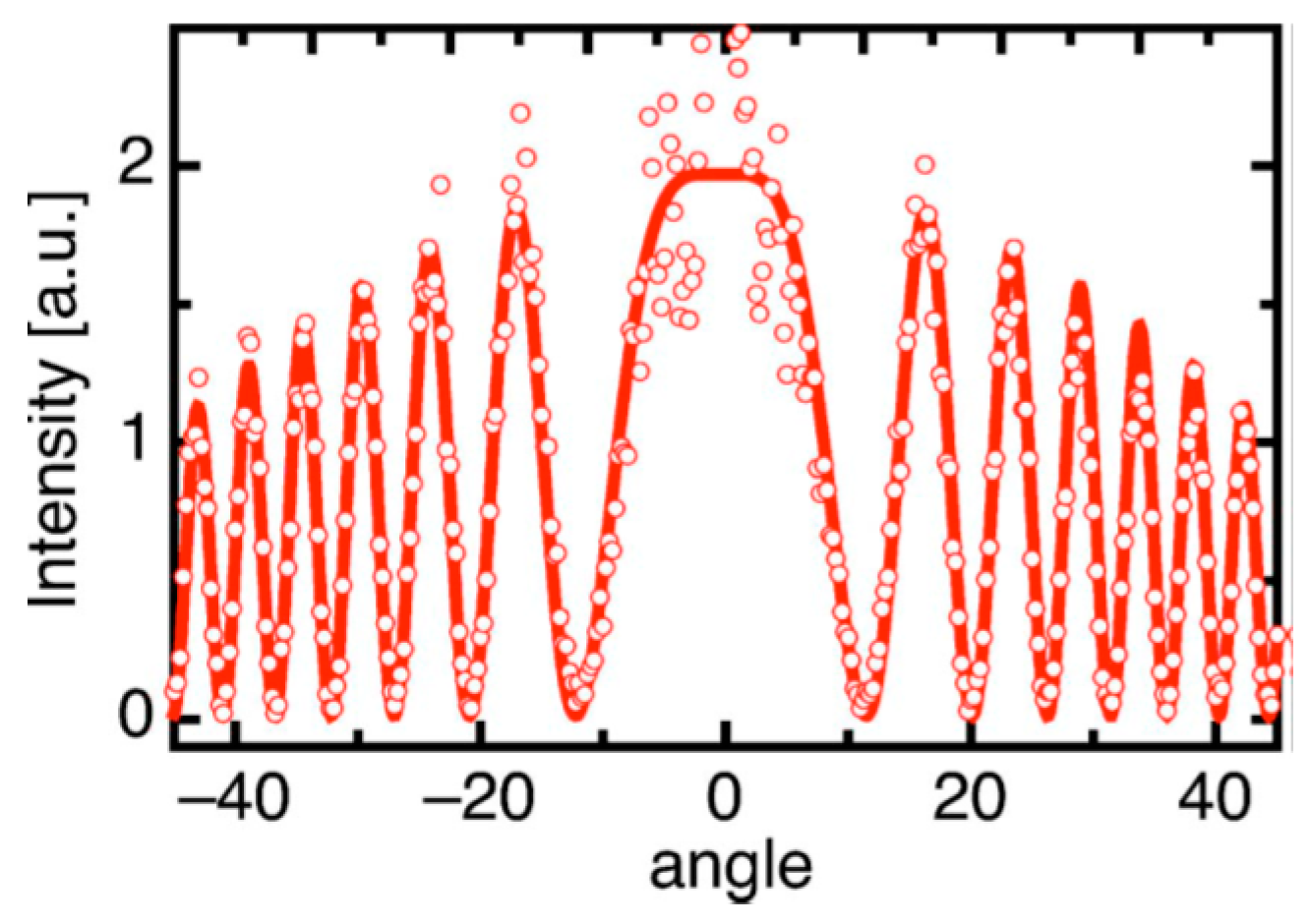
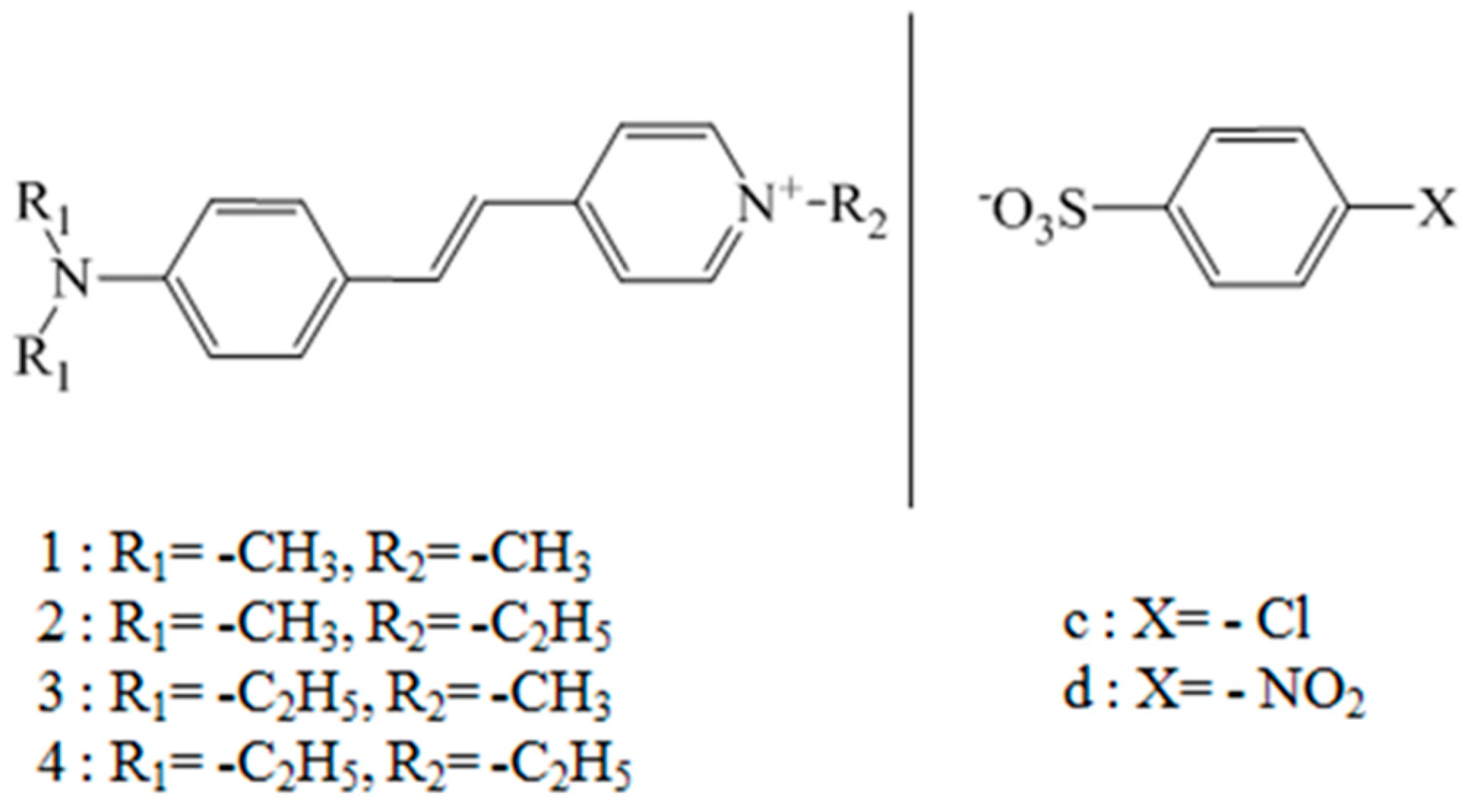


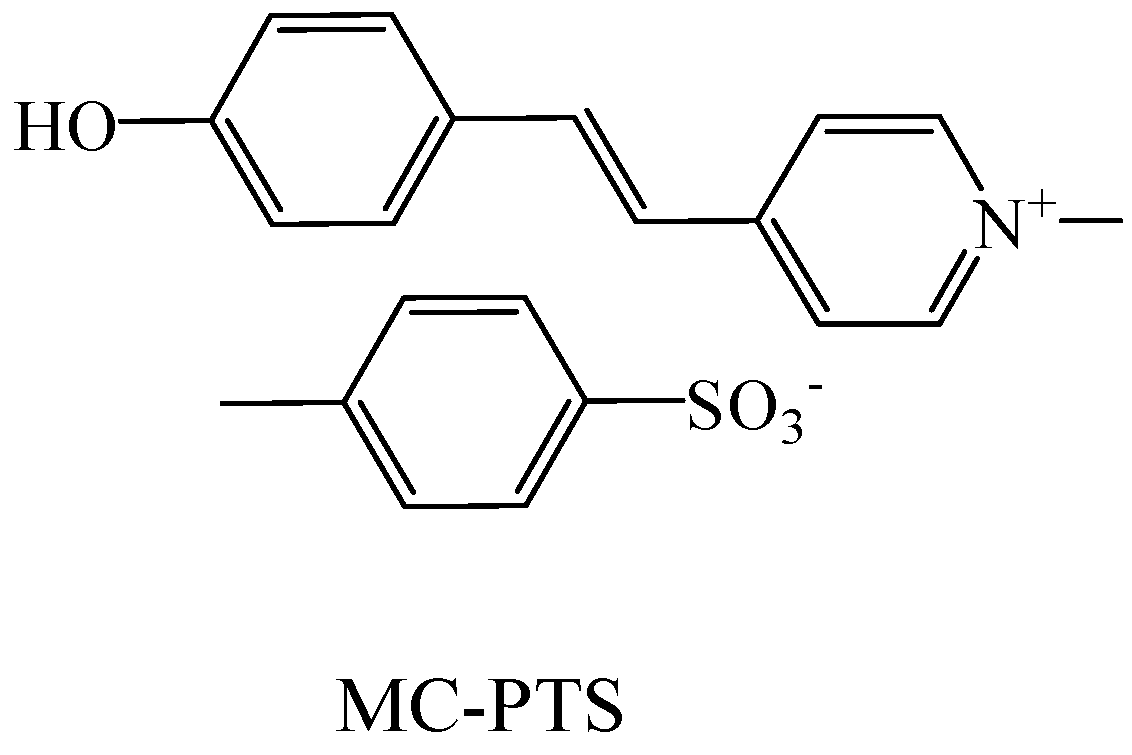
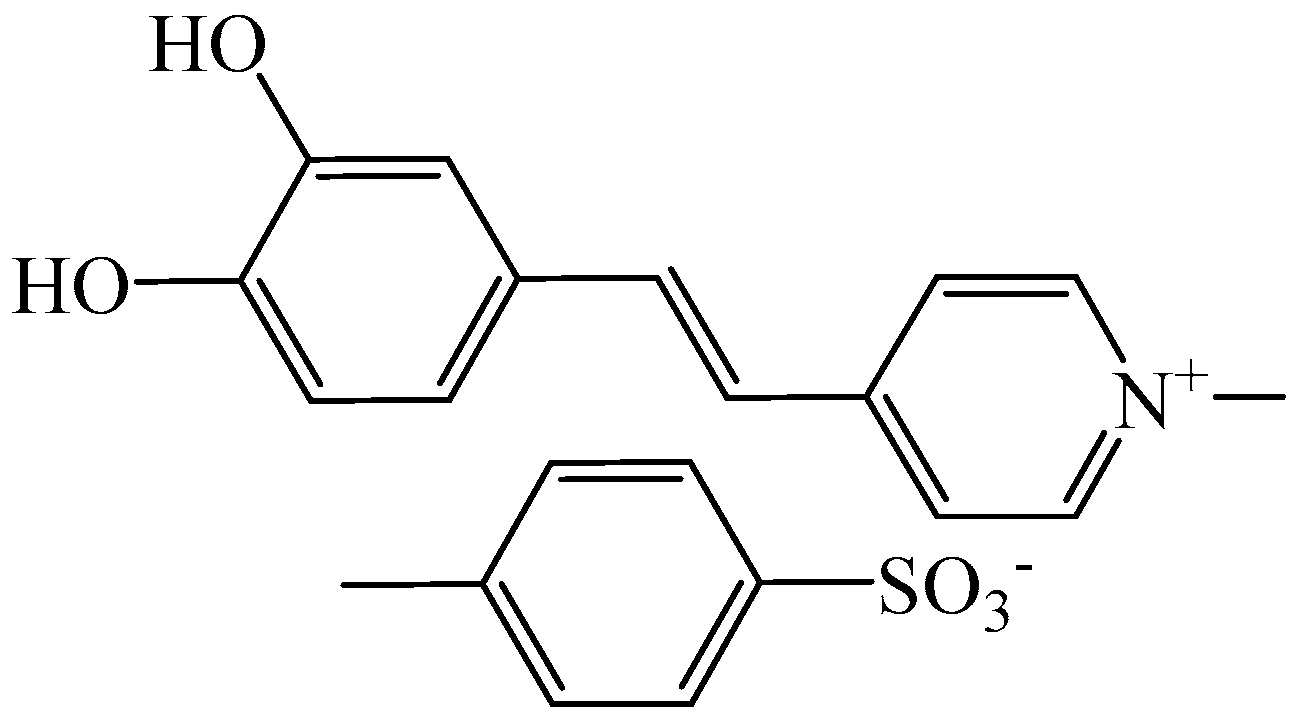
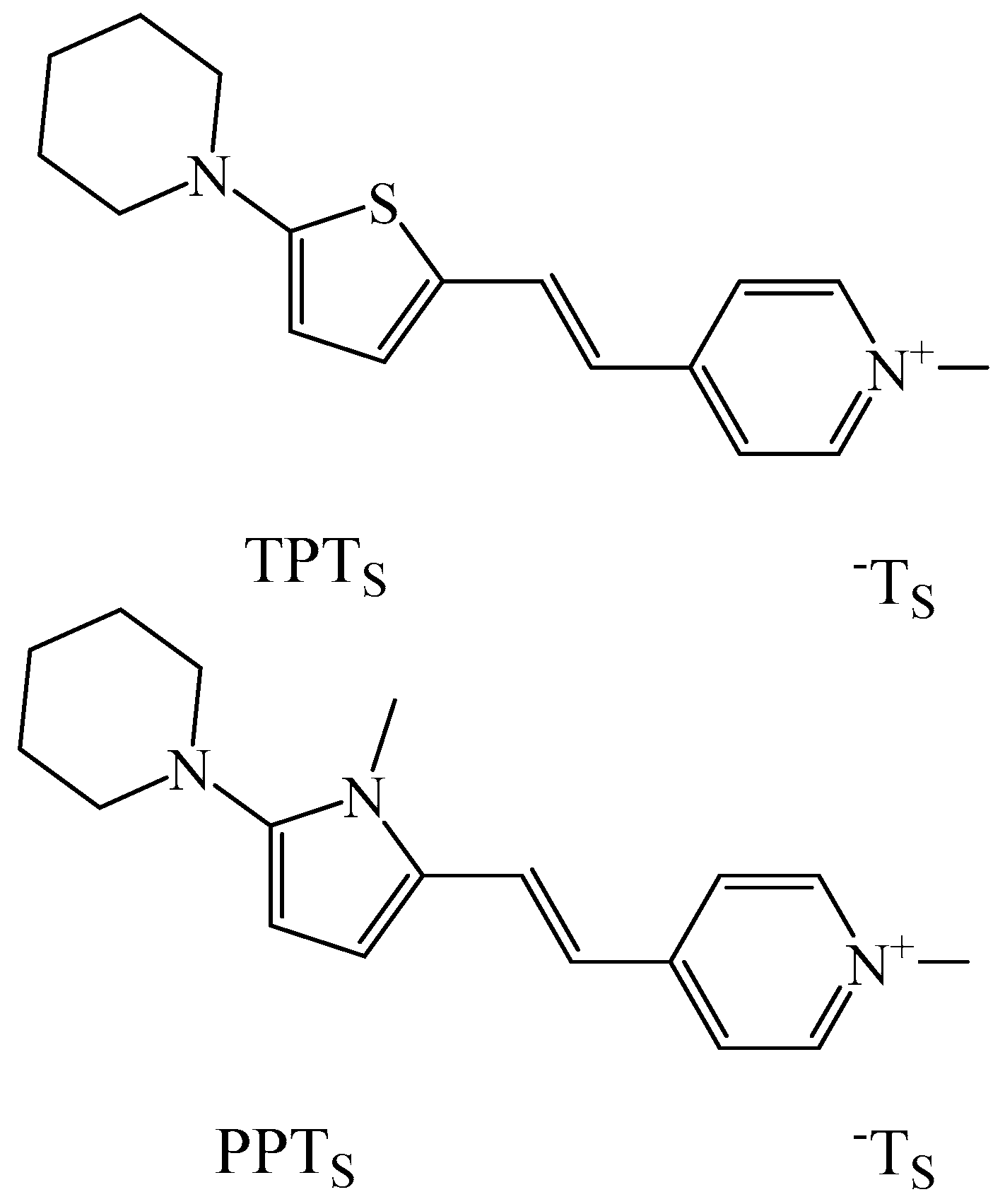
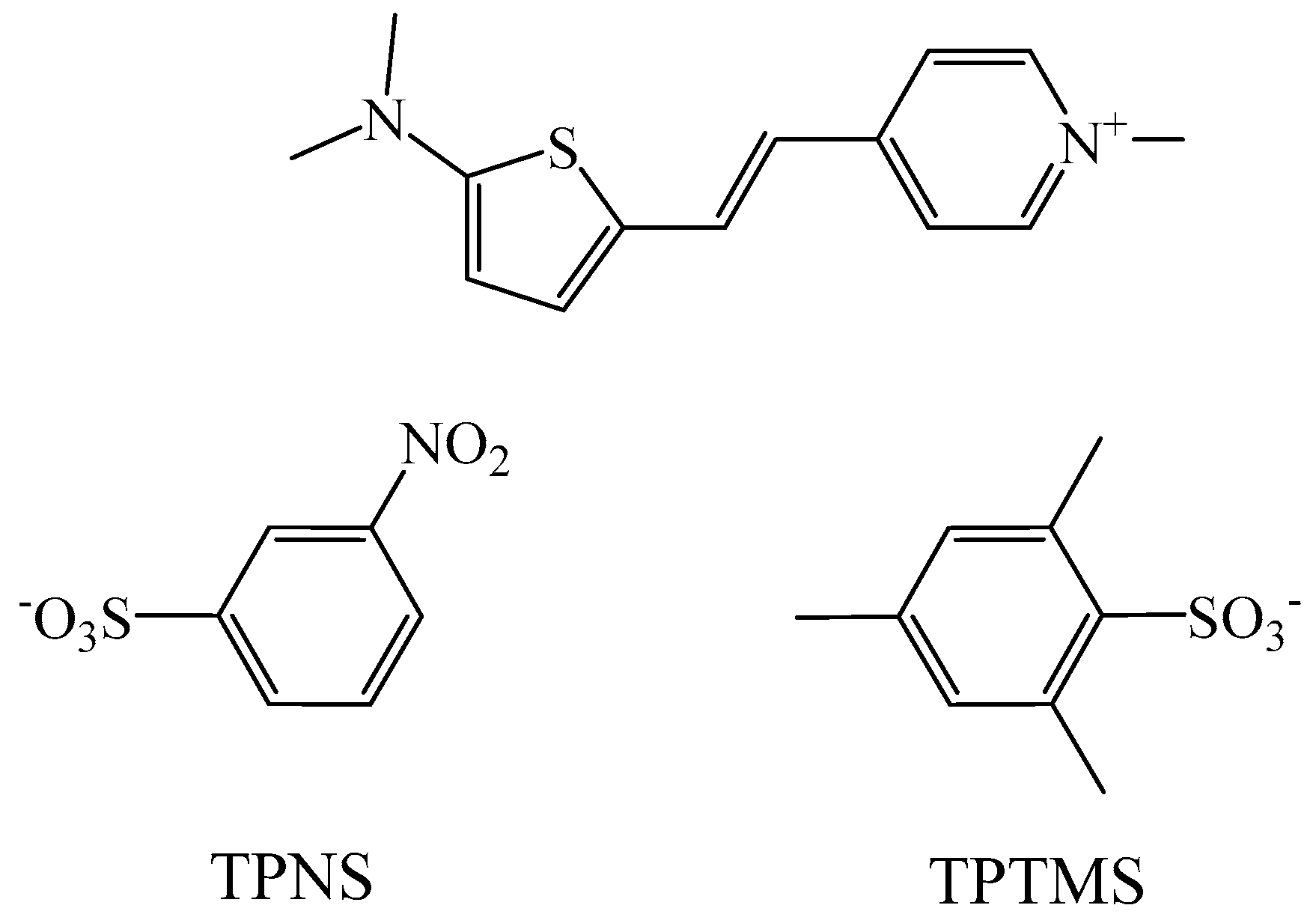







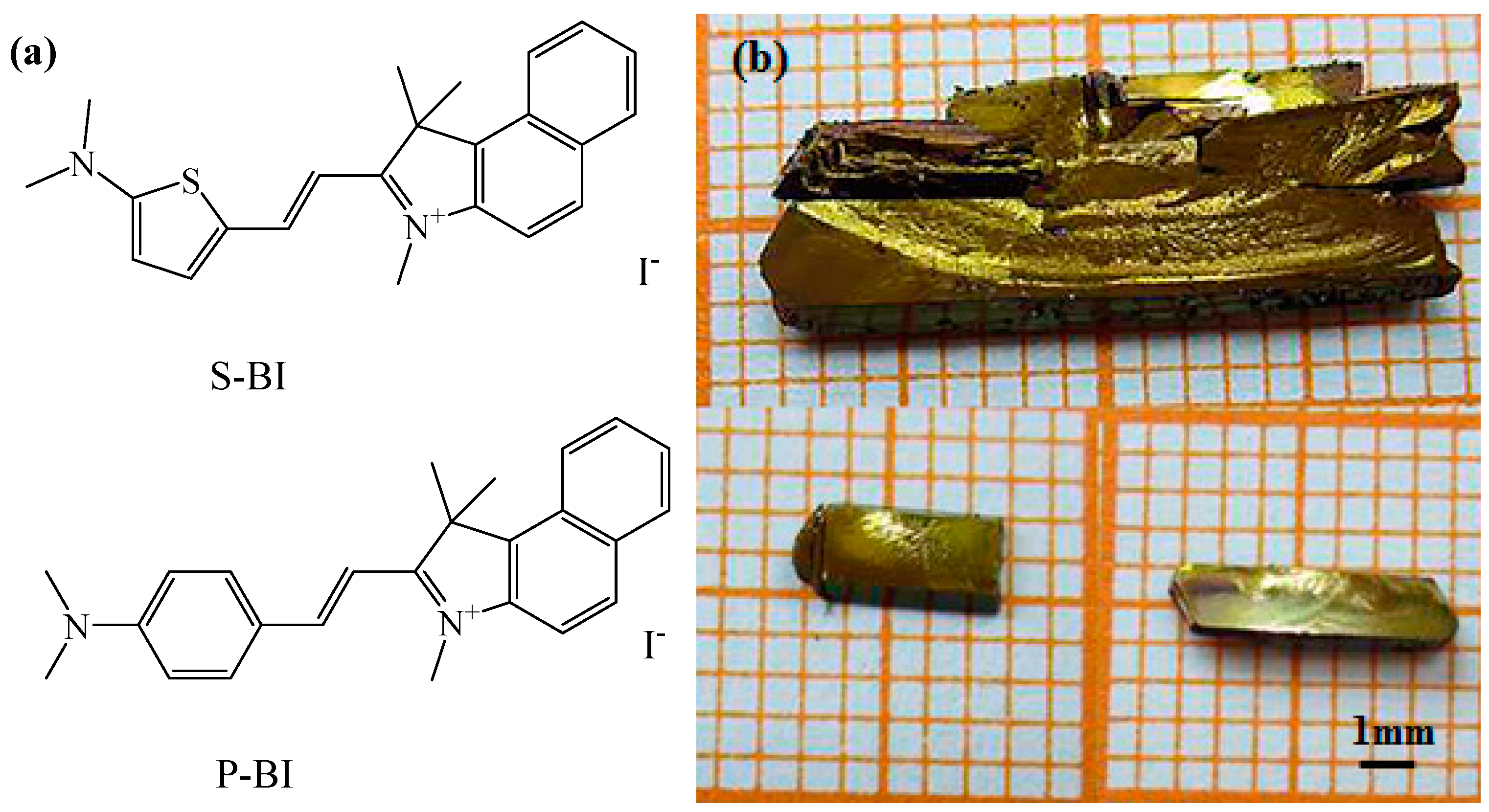
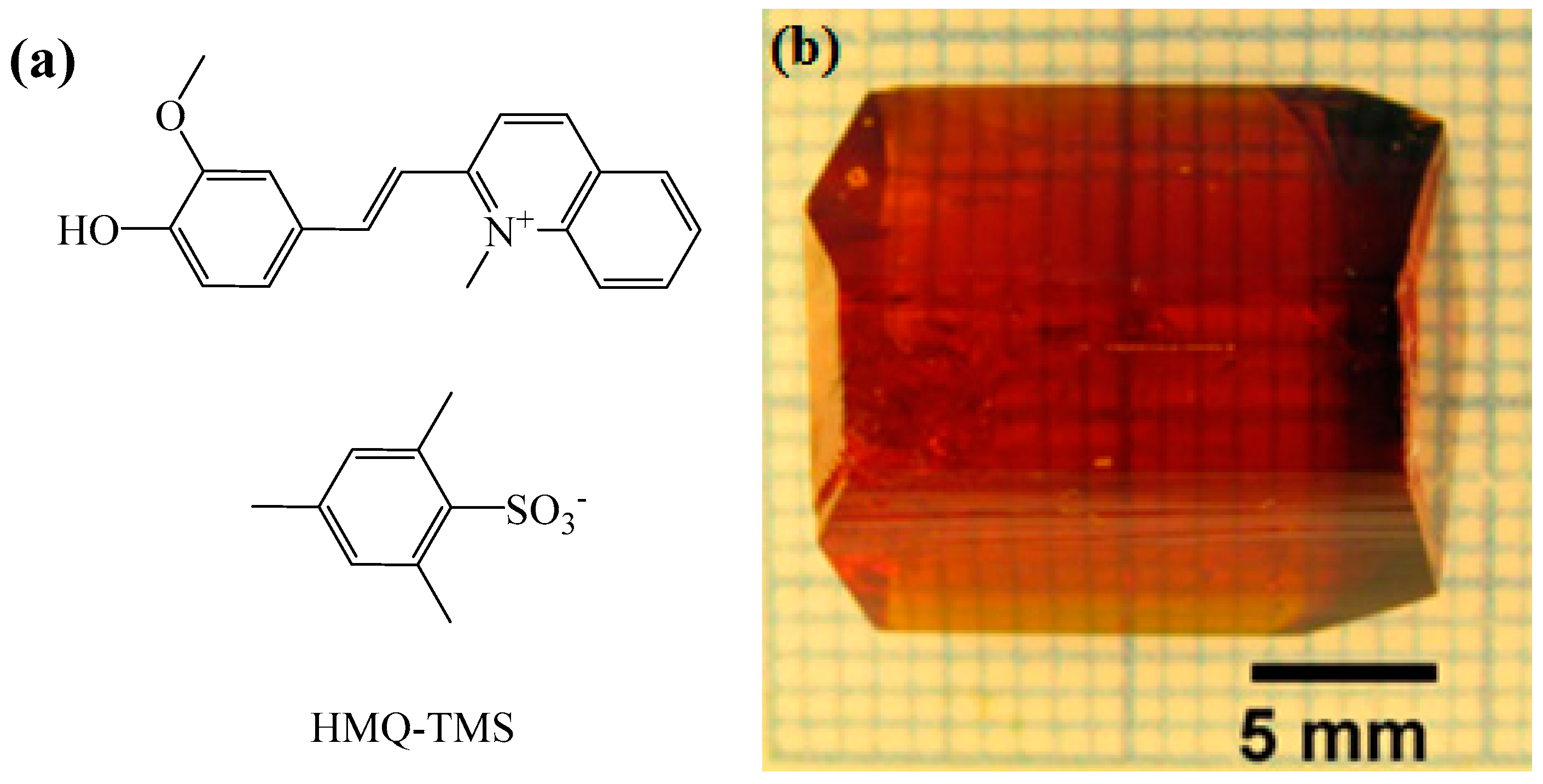
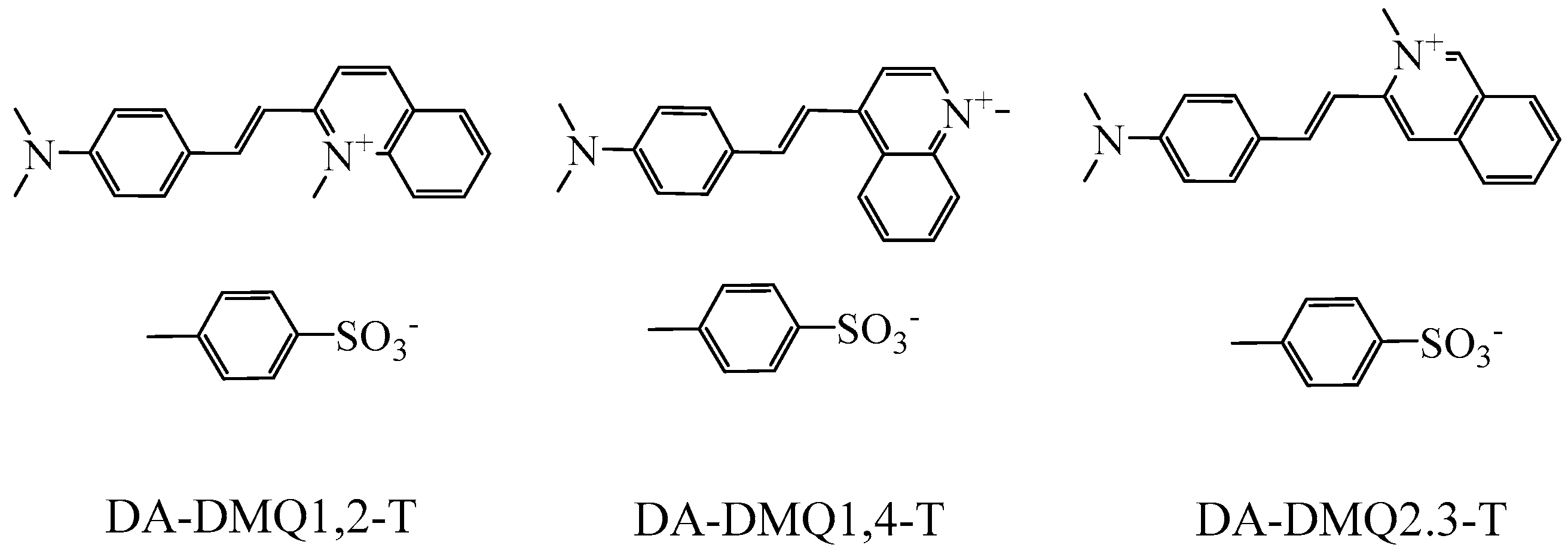



© 2016 by the authors; licensee MDPI, Basel, Switzerland. This article is an open access article distributed under the terms and conditions of the Creative Commons Attribution (CC-BY) license (http://creativecommons.org/licenses/by/4.0/).
Share and Cite
Liu, X.; Yang, Z.; Wang, D.; Cao, H. Molecular Structures and Second-Order Nonlinear Optical Properties of Ionic Organic Crystal Materials. Crystals 2016, 6, 158. https://doi.org/10.3390/cryst6120158
Liu X, Yang Z, Wang D, Cao H. Molecular Structures and Second-Order Nonlinear Optical Properties of Ionic Organic Crystal Materials. Crystals. 2016; 6(12):158. https://doi.org/10.3390/cryst6120158
Chicago/Turabian StyleLiu, Xiu, Zhou Yang, Dong Wang, and Hui Cao. 2016. "Molecular Structures and Second-Order Nonlinear Optical Properties of Ionic Organic Crystal Materials" Crystals 6, no. 12: 158. https://doi.org/10.3390/cryst6120158




